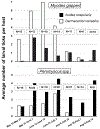The role of southern red-backed voles, Myodes gapperi, and Peromyscus mice in the enzootic maintenance of Lyme disease spirochetes in North Dakota, USA
- PMID: 39096783
- PMCID: PMC11670892
- DOI: 10.1016/j.ttbdis.2024.102385
The role of southern red-backed voles, Myodes gapperi, and Peromyscus mice in the enzootic maintenance of Lyme disease spirochetes in North Dakota, USA
Abstract
Lyme disease has expanded into the Great Plains of the USA. To investigate local enzootic transmission, small mammals were trapped in two forested tracts in northeastern North Dakota during 2012 and 2013. Peromyscus mice and southern red-backed voles, Myodes gapperi, comprised over 90% of all mammals captured. One site was dominated by Peromyscus (79% of 100 mammals captured). At the other site, M. gapperi (59% of 107 mammals captured) was more abundant than Peromyscus (36%). Immature stages of two tick species parasitized small mammals: Dermacentor variabilis and Ixodes scapularis. Larval I. scapularis ectoparasitism was significantly higher on Peromyscus (81% infested; 3.7 larvae per infested mouse) than M. gapperi (47% infested; 2.6 larvae per infested vole) whereas larval and nymphal D. variabilis ectoparasitism were highest on M. gapperi. Over 45% of infested rodents were concurrently infested with both tick species. Testing engorged I. scapularis larvae from Peromyscus (n = 66) and M. gapperi (n = 20) yielded xenopositivity prevalence for Borrelia burgdorferi sensu lato (s.l.) in these rodents of 6% and 5%, respectively. Progeny of field collected M. gapperi were used to determine host infectivity for a local isolate of B. burgdorferi sensu stricto (s.s.). Five M. gapperi were injected with spirochetes, infested with pathogen-free I. scapularis larvae on days 10, 20, and 40 after infection, and engorged larvae molted to nymphs. Subsamples of nymphs were tested by PCR for B. burgdorferi s. s. DNA and yielded infection rates of 56% (n = 100 nymphs tested), 75% (n = 8) and 64% (n = 31), respectively. The remaining infected nymphs were fed on BALB/c Mus musculus mice and 7 d later, mice were euthanized, and tissues were cultured for B. burgdorferi s.s. Nymphs successfully transmitted spirochetes to 13 of 18 (72%) mice that were exposed to 1-5 infected ticks. Theoretical reservoir potentials - i.e., ability to generate B. burgdorferi infected nymphs - were compared between Peromyscus and M. gapperi. At one site, Peromyscus accounted for nearly all Borrelia-infected nymphs produced (reservoir potential value of 0.935). At the other site, the reservoir potentials for Peromyscus (0.566) and M. gapperi (0.434) were comparable. The difference was attributed to differences in the relative abundance of voles versus mice between sites and the higher level of ectoparasitism by larval I. scapularis on Peromyscus versus M. gapperi at both sites. The southern red-backed vole, M. gapperi, contributes to the enzootic maintenance of Lyme disease spirochetes in North Dakota and possibly other areas where this rodent species is abundant.
Keywords: Dermacentor variabilis; Ixodes scapularis; Lyme disease; Myodes gapperi; Peromyscus; Reservoir potential.
Copyright © 2024 The Authors. Published by Elsevier GmbH.. All rights reserved.
Conflict of interest statement
Declaration of competing interest The authors declare that they have no competing financial interests or personal relationships that could influence the work reported in this paper.
Figures





References
-
- Bey RF, Loken KI, Wu CC, Lin TL, 1995. Experimental infection of the red-backed vole (Clethrionomys gapperi) with Borrelia burgdorferi. J. Wildl. Dis 31, 428–431. - PubMed
-
- Bishopp FC, Trembley HL, 1945. Distribution and hosts of certain North American ticks. J. Parasitol 31, 1–54.
-
- Boonstra R, Krebs CJ, 2012. Population dynamics of red-backed voles (Myodes) in North America. Oecologia 168, 601–620. - PubMed
MeSH terms
Grants and funding
LinkOut - more resources
Full Text Sources
Medical

